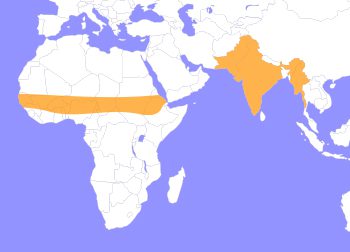Indian Ringneck Parakeet
Psittacula krameri
The ring necked parakeet, also known as the rose-ringed parakeet, is a medium-sized parrot in the genus Psittacula, of the family Psittacidae. It has native ranges in Africa and South Asia, and is now introduced into many other parts of the world. Feral populations have been able to establish themselves and are bred for the exotic pet trade. One of the few parrot species that have successfully adapted to living in disturbed habitats, it has withstood habitat loss of urbanisation and deforestation. In northern and western Europe, they are popular pets, birds have been known to escape and form wild populations. These parakeets have also proven themselves capable of living in a variety of climates outside their native range, and are able to survive low winter temperatures in Northern Europe.
In the wild, ring necked parakeets usually feed on buds, fruits, vegetables, nuts, berries, and seeds. Wild flocks also fly several miles to forage in farmlands and orchards, causing extensive damage. They have been known in India, to feed on farmers crops of cereal grains. In Egypt during the spring, they feed on mulberry and in summer they feed on dates. These trees also double as homes, they will nest inside palm trees and eat from sunflower and corn fields. In captivity, ring necked parakeets will take a large variety of food and can be fed on a number of fruits, vegetables, pellets, seeds, and even small amounts of cooked meat for protein.

Ringneck Parakeets occur naturally in southern Asia, ranging across India, and Central Africa.
HABITAT -They can be found in urban, suburban, and rural forested areas, across Africa and parts of eurasia.
DIET -In the wild they will eat fruits, vegetables, nuts, berries, and seeds.
FUN FACT -They were once considered sacred based on their remarkable ability to mimic human speech.
SOCIAL BEHAVIOR -They are sociable forming flocks in the wild. They can be affectionate pets.
ACTIVITY -They are diurnal being most active during the day and resting during the evening.
PREDATORS -Predators include grey squirrels, which prey on their eggs, crows, owls, snakes, and humans.
SIZE -An adult ringneck parakeet on average weighs 4.5 oz. They are 16 in. in length on average.
RELATIVES -There are four subspecies of the ring necked parakeet, including the African rose-ringed parakeet and Indian rose-ringed parakeet.
CONSERVATION -Ring necked parakeets are categorized as LC (Least Concern) by the IUCN.
Cub Creek Animal Care Information
Housing - Our ringnecks live in Lemur Landing, our large lemur enclosure in the dining hall! They are given lots of space to fly and trees to perch on, just like they would have in the wild. The ground is covered in mulch that can absorb any excrement. There is also a fountain in their enclosure that they can climb on or use as a bird bath. Our female has also taken the boxes built for the bettongs and used them as nesting boxes!
Diet - These birds are fed ZuPreem FruitBlend medium bird pellets that give them all the vitamins and nutrients they need to be healthy. They also get fresh bird salad daily, which includes apple, shredded sweet potato, and greens. There are several bowls that allow them access to fresh water. They love to steal the lemurs food as well, especially bananas.
Enrichment - These birds get most of their enrichment through living in a multi-species enclosure. Not only are there lemurs, but also Red Rump Parrots, bettongs, and sometimes tortoises. Between these interactions and the many places in the large enclosure to explore, these birds have plenty to do everyday.


